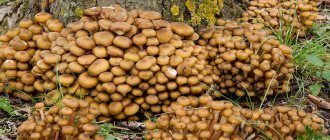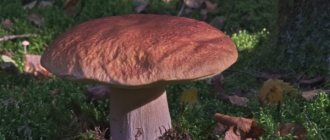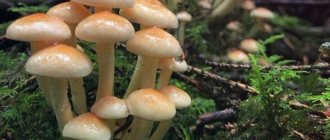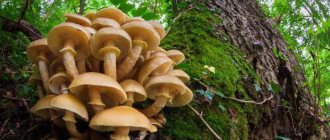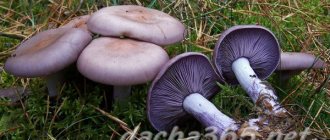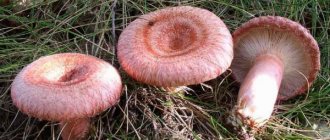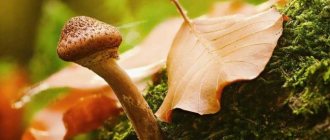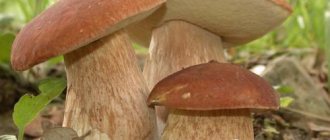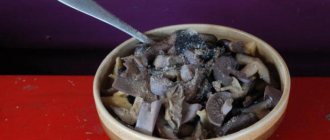Honey mushrooms is a word that unites a group of mushrooms from various families and genera. Why did these mushrooms get this name? In fact, everything is extremely simple, the word “honey agaric” has a common root with the word “stump”, and as you know, most honey mushrooms prefer to grow on wood (stumps, dead trees, weakened living and dry trees). The only exception here is meadow honey mushrooms; they grow on the ground, and received their name rather because of their external similarity with other representatives of this group.
- Hypholoma capnoides
As practice shows, when many people talk about honey mushrooms, they mean a specific type of mushroom, namely “autumn honey mushrooms (armillaria mellea),” since they are perhaps the most famous among amateur mushroom pickers. In fact, there are many other very tasty mushrooms included in the honey mushroom group, which are often avoided by people new to the mushroom kingdom.
Next, I propose to get acquainted with the main mushrooms related to honey mushrooms. You may well have seen some of them in parks or in the forest, and some of them may have even been seen in stores.
Types of mushrooms
Let's start with something pleasant, namely edible and tasty mushrooms, because they make up the vast majority on our list. However, it is worth noting that there are not so many poisonous mushrooms in nature.
1. Summer honey fungus (Kuehneromyces mutabilis) - edible. This mushroom appears in the forest earlier than most other types of honey mushrooms. Sometimes you can meet him as early as the beginning of May. The very name “summer” should be considered conditional, because it occurs in late spring, summer and autumn. The mushroom most often grows in large groups, on stumps, dry and rotten wood. Summer honey fungus can rightfully be considered one of the most delicious representatives of honey mushrooms. The mushroom has a very pleasant smell and is great for various culinary treatments. Summer honey mushrooms can be fried, pickled and even made into soup.
2. Autumn honey fungus (Armillaria mellea) - edible. The most popular and recognizable type of honey mushroom is undoubtedly the autumn honey fungus. It begins to grow actively from the end of August, when the average daily temperature drops to 10-15 degrees Celsius, and ends its fruiting only in late autumn. The fungus often parasitizes weakened living trees of various species; it also grows on dry wood, stumps, and dead wood. Often found in numerous families, which sometimes cover a significant part of the tree surface. Autumn honey fungus contains many useful microelements. Before eating, the mushroom must be boiled, as in its raw form it can cause mild stomach upset. Autumn honey mushrooms are used for pickling, pickling, drying and frying.
3. Honey fungus (Marasmius oreades) - edible. This small and inconspicuous fungus from the non-rot family has gained recognition among many mushroom pickers due to its wide use in cooking. Meadow mushrooms are fried, dried, salted and made into soup. These honey mushrooms grow in groups from June to October, sometimes forming entire rows of mushrooms. Most often they appear in open spaces - the edges of fields, meadows, forest edges, in gardens and vegetable gardens. An interesting fact is that some people prefer to cut this mushroom with scissors, since it is not very convenient to do this with a knife due to its small size.
4. Winter honey fungus (Flammulina velutipes) - edible. One of the few mushrooms that can grow in winter. In sub-zero temperatures, winter mushrooms do not lose their taste, so they can even be collected frozen. These mushrooms grow from late autumn to spring, choosing for their appearance the trunks of weakened living trees, stumps, and various rotten wood. Winter mushrooms are found not only in the forest, but also in parks, courtyards, and even in the city. Before eating, the mushroom should be boiled for 15-20 minutes, after which it is usually salted and pickled.
Beneficial features
Honey mushrooms are useful for anemia
The benefits of consuming this type of mushroom are great. They contain many useful substances, such as:
- B vitamins (mostly B1 and B2), also C, PP and E;
- phosphorus, iron, zinc, calcium and other trace elements;
- sufficient amino acid content;
- cellulose;
- proteins.
Nutritional value (BJU) of 100 g of mushrooms looks like this:
- 2.2 g proteins;
- 1.2 g fat;
- 0.5 g carbohydrates.
According to the description, the amount of microelements in the mushroom is close to that in river fish, so mushrooms will be an excellent alternative to seafood, and will also help diversify your daily diet. The calorie content of autumn honey mushrooms per 100 g of product is 17 kcal, which makes them practically irreplaceable for those who are on diets. The autumn mushroom is an excellent choice for vegetarians who refuse to eat fish and meat. Its use will serve to prevent disorders associated with bone tissue.
Mushrooms have antimicrobial properties and are considered a natural antiseptic; they also have anti-cancer properties. They are useful to take for problems with the gastrointestinal tract: they fight bacteria no worse than antibiotics or garlic. Regular consumption of these mushrooms helps prevent cardiovascular diseases.
They have found their use in medicine in the treatment and prevention of the following diseases:
- fibroma;
- myoma;
- adenoma;
- mastopathy;
- thrombophlebitis;
- increased blood clotting, etc.
Honey mushrooms are also useful for anemia, because the high content of magnesium, copper and other trace elements helps improve hematopoiesis. For this, only 100 g of these mushrooms per day is enough. In addition, they will also be useful for those who suffer from E. coli or Staphylococcus aureus.
False honey mushrooms
All representatives of false mushrooms belong to one common genus “Hyfoloma”, which indicates their close relationship, and, accordingly, similarity in appearance.
1. Hypholoma capnoides - edible. An absolutely edible mushroom of good quality, despite the fact that it is classified as a false mushroom. The main feature of the honey fungus is the fact that it grows exclusively on stumps and decaying wood of coniferous trees. In the vast majority of cases on pine, less often on spruce. The danger for inexperienced mushroom pickers lies in its great similarity to the poisonous sulfur-yellow honey fungus, which is described below. Therefore, remember that you should not take a mushroom from the forest that you are not sure about! In cooking it is used similarly to summer honey fungus.
2. Brick-red honey fungus (Hypholoma lateritium) - conditionally edible. A rather controversial mushroom, since different sources provide different information about its edibility. Some authors label brick-red honey fungus as mildly poisonous, but in most books it is described as edible. Grows on stumps and rotting deciduous trees throughout the summer and fall. It is similar to the poisonous sulfur-yellow honey fungus. On the forums you can meet people who collect brick-red honey fungus, but personally I have never taken it, and why, when there are other edible and tasty mushrooms?
3. Sulfur-yellow honey fungus (Hypholoma fasciculare) - poisonous. A poisonous representative of false mushrooms. The mushroom is found in the forest from late May until late autumn. It prefers to grow on rotten trees, stumps, and sometimes on the ground if it contains remains of decaying wood. Sometimes it bears fruit in large numbers. Sulphur-yellow false honey fungus is very similar to the edible sulphur-yellow false honey fungus. It is worth highlighting two main differences between these mushrooms: 1. sulfur-yellow honey fungus has plates of a greenish tint (in the sulphurous honey fungus they are gray), 2. sulfur-yellow honey fungus grows exclusively on coniferous trees (pine, less often spruce), sulfur-yellow on any. When eaten, sulfur-yellow honey fungus causes stomach upset, nausea, and vomiting.
Do you need help?
False honey mushrooms are very dangerous, but with timely assistance, the negative consequences can be minimized. In case of mushroom poisoning, you should immediately consult a doctor.
You can provide first aid yourself:
- Rinse the stomach with plenty of boiled water with the addition of soda (take 1 tsp of soda per 1 liter of liquid). After the solution is drunk, vomiting is induced. The procedure is repeated several times.
- Give an absorbent to the patient (activated carbon is suitable).
- Lay the poisoned person down and cover with a warm blanket.
- Provide plenty of fluids after gastric lavage.
To date, there is no information about deaths after poisoning with false mushrooms.
False honey mushrooms have a strong external resemblance to the real ones. They are found on rotting wood, as well as old stumps, but they do not have the same culinary qualities. Also, false honey mushrooms can be hazardous to health. Among the false mushrooms there are no deadly poisonous species, but they will not bring any benefit at all.
0
0
Copy link
Dangerous double honey mushrooms
Galerina bordered
(Galerina marginata) - deadly poisonous. Grows from June to the end of October on stumps and rotten wood, mainly coniferous trees (less often deciduous). Sometimes appears on the ground that contains fragments of decaying wood. Most often found in small groups. This mushroom has the greatest similarity with summer honey fungus, and relatively little with winter honey fungus. The main difference between the bordered galerina and the summer honey fungus is the absence of scales on its stem. In addition, summer honey mushrooms have a pronounced, pleasant mushroom smell, while in galerina it is extremely weak (according to some sources, slightly mealy). The mushroom contains amatoxins, the same ones found in the toadstool. Symptoms of poisoning appear 6-30 hours after eating mushrooms. A lethal dose is approximately 20-30 small fungi.
Botanical description
hat
The cap of the autumn honey fungus is round, matte, often with wavy edges and a dark flat tubercle in the middle. At a young age, hemispherical, dotted with small scales, which then disappear. Scale color: white, yellow, brown, brown, black. As it grows, it opens up and becomes convex and finally flat-prostrate. Diameter: on average 3-10 cm, but can reach 15-20 cm.
The color of the skin of a young mushroom, depending on what tree it grows on, can vary from greenish-olive, honey-yellow and light beige to dark gray, yellow, gray, reddish-brown, brown. In older mushrooms it acquires a uniform brown-brown color.
Hymenophore
Hymenophore (lower part of the cap) - sparse, thin, descending plates. The color starts out whitish, then changes to yellowish white and yellow. May have small brown spots. Width of autumn honey fungus plates: 4-8 mm.
The spore-bearing layer is tightly covered with a cotton-like blanket. The spores are smooth, ovoid or ellipsoid, colorless. Size: 7-9.5 x 5-6.5 microns. Color of autumn honey fungus spore powder: white.
Leg
The leg is thin, round, smooth or thickened towards the base, straight or curved. At a young age it is solid, cotton wool-like, then hollow, elastic, dense. The surface is dry, matte, covered with fibrous-flaky scales. The color of the cap is lighter, yellowish, ocher-brown, darker at the base, to brownish-brown. Height: 5-12, up to 20 cm, diameter: 0.5-2.5 cm.
In young autumn mushrooms, the stem and cap are connected by a filmy cotton blanket. After its rupture, a clearly visible narrow membranous whitish ring with a yellow edge remains on the stalk, which is rarely preserved in mature mushrooms.
Pulp
The pulp of the autumn cap is dense and becomes thin with age. Color: whitish, does not change when cut. In the stalks it is fibrous, in older mushrooms it is coarse. Pleasant mushroom taste and aroma
What other mushrooms are called honey mushrooms?
- Yellow-red row
(Tricholomopsis rutilans) is conditionally edible. This mushroom is often called “yellow-red honey fungus”, since for its growth it chooses stumps and dry coniferous trees. The yellow-red row is a beautiful mushroom, but its taste is very mediocre. Only young fruiting bodies can be collected, because with age the pulp acquires a bitter taste. - Golden scale
(Pholiota aurivella) is edible. Another popular name for this mushroom is “royal honey fungus.” Golden scale grows in groups on dry, less often living, deciduous trees from summer to late autumn. The pulp of the mushroom, in addition to its pleasant taste, contains many vitamins and minerals necessary for humans. Some people confuse golden scale with the common common scale, which is conditionally edible. - Wood-loving collibia
(Gymnopus dryophilus) is conditionally edible. This mushroom is often referred to as “spring honey fungus.” In the forest, collibia can be found from mid-May to November, with peak fruiting usually occurring in June-July. Spring honey fungus grows in groups on the ground or rotten remains of wood. Although wood-loving collibia is a conditionally edible mushroom, it is usually characterized as “tasteless.” This mushroom can be confused with honey fungus.
How to store
Autumn honey fungus is a universal mushroom and has shown itself well in all types of preparations. The most hassle-free way to please yourself and your family with a delicious mushroom dish with honey mushrooms even out of season is drying. Moreover, before drying, autumn honey mushrooms do not need to be washed and boiled.
Young and neat honey mushrooms with a cap diameter of no more than 2.5 cm are selected for pickling. This is one of the most favorite dishes with honey mushrooms for many. Even the harsh legs of pickled mushrooms are particularly attractive, and the marinade gives the preparation a unique piquant taste and aroma. When salted and pickled, autumn honey mushrooms take on a brownish or brownish color.
However, you should pay attention that only the hot method is suitable for pickling and pickling autumn honey mushrooms, i.e. they must be boiled first. With the dry or cold method, poisoning is possible.
A good way to prepare autumn mushrooms is freezing. Both fresh mushrooms and boiled or fried mushrooms are suitable for this. Fresh mushrooms should first be washed and dried.
Autumn honey mushrooms are also used for the winter as a component for various canned vegetables. For example, mushrooms are fried with the addition of onions and carrots. The resulting mass is filled hot into prepared jars, topped with melted pork fat (lard) and hermetically sealed.
But what to do with the tough legs of old mushrooms? They are dried and ground into powder, which is used as a seasoning in the preparation of soups, sauces, etc.
Honey mushrooms from the store
Many of you have most likely seen yellowish-orange jars of pickled honey mushrooms on store shelves. Also, these mushrooms are often sold frozen, both by weight and in packages. I think you will agree that they are completely different from autumn, summer or winter mushrooms. So what are sellers hiding under the familiar word “honey mushrooms”? Meet the edible flake or nameko
!
These mushrooms are actively cultivated in China and Japan. The name "nameko" is taken from the Japanese language, and it means "slippery mushrooms", which is explained by the presence of jelly-like mucus on the caps of fresh fruiting bodies. The taste of edible flakes, of course, differs from the taste of real honey mushrooms, but this did not prevent these mushrooms from being widely used in cooking.
China is the main supplier of Nameko to Russia. But why don’t companies selling products write the real name of these mushrooms? Most likely this is due to marketing; most people are not aware of any flakes, and the simple and understandable name “honey mushrooms” increases people’s trust in the product.
So my review has come to an end. Of course, there are still quite a few mushrooms that are in one way or another related to the term “honey agaric,” but I considered it necessary to mention only those that I know personally and that most amateur mushroom pickers come across. I hope the information was useful to you!
Contraindications
With all the advantages of honey mushrooms, they also have a number of contraindications, in the presence of which their use should either be limited or completely stopped. They are contraindicated:
- women during pregnancy and lactation;
- people with heart pathologies;
- those who have digestive problems;
- people with kidney failure.
The mushroom should also not be given to children under the age of 12, which is due to the immaturity of the digestive system and its inability to absorb some of the components of the mushroom pulp, which can lead to intoxication of the body and health problems.
Excessive consumption of honey mushrooms leads to pancreatitis, inflammation of the pancreas, and problems with the gastrointestinal tract. Before consumption, it is necessary to carry out mandatory heat treatment of mushrooms.
Habitat
Summer honey fungus is a mushroom widespread in temperate and warm regions. Prefers a non-arid climate. Loves damp places.
It usually grows in large colonies, forming clumps. And unlike the autumn honey fungus, which most often settles on living trees, this mushroom prefers dead wood. According to some sources, it can also be seen on weakened and dying trees.
Fruits very abundantly, not inferior to autumn and winter honey mushrooms. Moreover, during the season, the crop can be harvested in the same place several times.
Growing at home
Mushrooms are easy to grow at home. To do this, you just need to have a suitable stump from a deciduous tree. Alder, poplar, birch or maple stumps are perfect. The stumps of coniferous trees are not suitable for these purposes, since they contain specific compounds inherent to them - resins, located in special containers. In coniferous stumps, the mycelium takes longer to develop, and the taste of the crop is worse.
The easiest way is to infect the stump with mycelium. To do this, small holes are drilled in the stumps; holes 5 cm deep and about 0.5 cm in diameter are enough. Usually they are made in a checkerboard pattern, at a distance of 15 cm from each other. Seed material is poured into these holes, then everything is covered with film: this way the mushrooms grow faster. The ideal time for planting summer honey fungus is May.
With proper care, harvesting is carried out the next year after sowing. Honey mushrooms grown at home will produce a harvest for 3-6 years. On stumps of hard (deciduous) trees, the mycelium will produce a harvest longer.
Growing this type of mushroom in a personal plot can lead to infection of fruit trees. The mycelium destroys the wood of the tree and it dies. Therefore, you must take preventive measures to protect your garden from “encroachments” by new residents.
